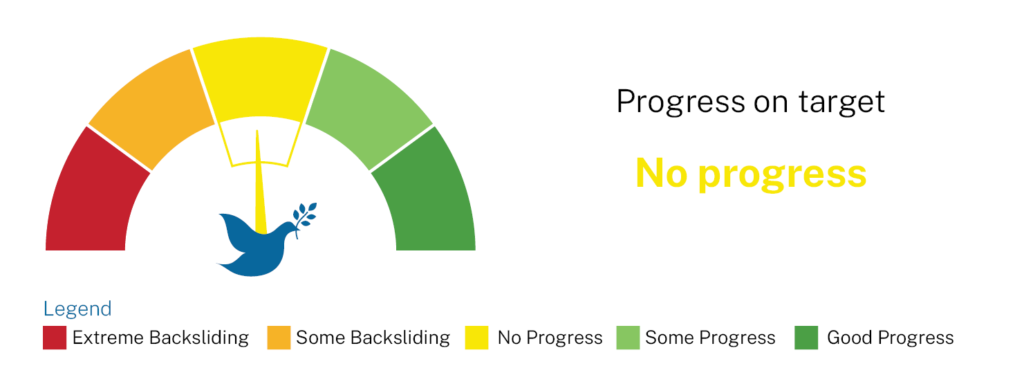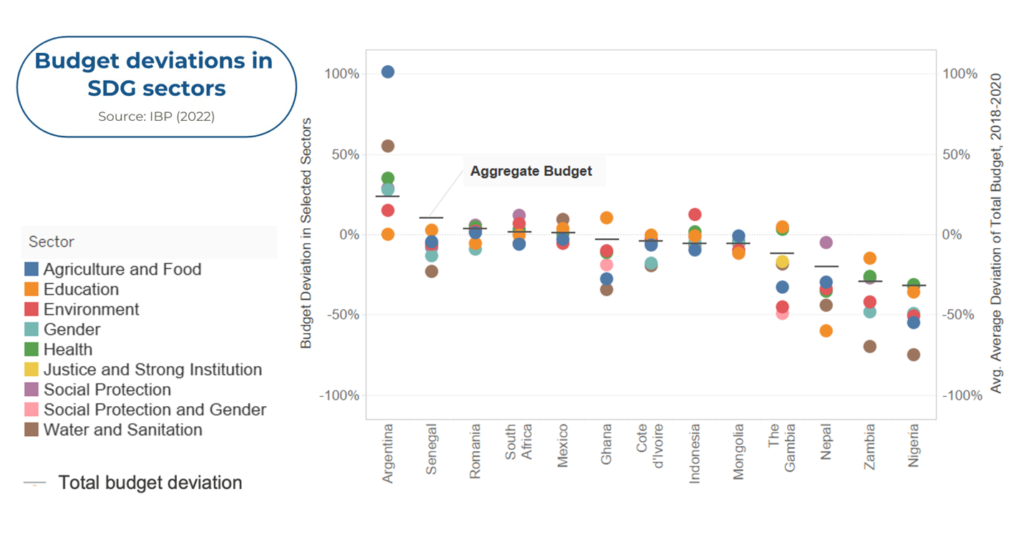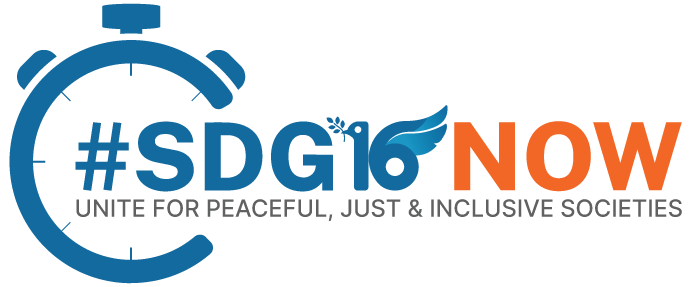Target 16.6: Develop effective, accountable and transparent institutions at all levels

There has been little progress in improving the target. Many countries show a significant deviation from approved budgets. Transparency of budgets has improved long term while participation is very low.
Authors of chapter

Context and Interlinkages
Ensuring effective, accountable and transparent institutions is crucial for the success of the SDGs, from supporting those in extreme poverty, to health care and education, to sustainable procurement, and protecting the oceans. The ability of governments to implement their budgets as planned – known as budget credibility – is essential for those institutions. Lack of credibility for the planning and budgeting system as a whole can compromise the delivery of critical services necessary for the attainment of the SDGs, and more broadly, inhibit the transformation towards sustainable and resilient societies.1 At the same time, effective public services are at the heart of achieving the SDGs and affect all of them.
Effective allocation and implementation of national resources through government budgets is one critical and core element of how governments can accelerate progress on addressing poverty and inequality to achieve the SDGs by 2030. Many countries face challenges related to governments implementing their budgets as planned, including both the transparency of government spending (as it relates to the prioritised commitments outlined for the SDGs)2 and strategically allocating spending to deliver services and support for the most vulnerable populations. Budget credibility challenges are especially acute in low-income or fragile states.3 The target further interlinks with SDG16 targets on corruption (16.5), public participation (16.7), birth registration as a service (16.9), access to information (16.10) and national institutions (16.a), as well as the SDG16+ target on institutions and policies for poverty reduction (1.B).
The 2030 Agenda and the Addis Ababa Action Agenda on financing for development (FfD) call for governments to report on their spending and progress towards the achievement of the SDGs. The Addis Ababa Action Agenda pledges to “increase transparency and equal participation in the budgeting process.”
Progress on indicators
Official Indicators:
- 16.6.1: Primary government expenditures as a proportion of original approved budget, by sector (or by budget codes or similar) (Tier I)
- 16.6.2: Proportion of population satisfied with their last experience of public services (Tier II)
Additional Indicators:
- Open Budget Survey
- Sectoral spending
SDG Indicator 16.6.1 focuses on the degree to which governments implement their budgets as planned, which is important for understanding whether governments are keeping their promises and delivering as planned on goods and services for citizens. Analysing and engaging on SDG 16.6.1 can create opportunities for civil society, governments and international development actors to expand the dialogue around the SDGs and ensure that resources for sustainable development deliver as promised.
According to the World Bank Public Expenditure and Financial Accountability (PEFA) Secretariat, of the 152 countries with available data for the period 2010 – 2021, half of the countries show less than 5 per cent deviation in the budget execution compared to the approved budget, while one third of the countries’ budgets deviate within 5-10 per cent, and the budgets of 18 per cent of the countries show deviation more than 10 per cent.4 These figures are significant – many countries’ health budgets do not amount to 10 per cent of the total government budget. The larger the deviations, the greater the effects are likely to be on allocative efficiency and service delivery.5
Data for 16.6.2 on satisfaction of public services is limited. The UNDP has only recently developed a survey-based indicator focusing on 3 areas: healthcare, education and administrative services provided by governments based on surveys of satisfaction in the last 12 months.6 The World Bank’s Government Effectiveness Estimate global average – which measures public perceptions relating to the quality of public services and other issues – has remained unchanged from 2015 until 2021.7
Additional Indicators
The indicators for 16.6, do not fully capture the scope of the target. The calculations for SDG Indicator 16.6.1 are based on data in government budget and accounting reports, which should be accessible to the public according to international standards of fiscal transparency.
However, in many countries, this data is often not publicly available: International Budget Partnership’s (IBP) latest Open Budget Survey found that almost a third of countries do not publish a year-end report. 76 percent of countries publish the In-Year Report on the implementation of budget policies, 69 percent publish the Year-End Report after the fiscal year has ended, and still fewer — 41 percent — publish the Mid-Year Review. Few countries have government budget reports that provide explanations about budget deviations, meaning there is little public information whether budget deviations are justified, or whether they are impacting the performance of government programmes and services in these sectors.
Further, public participation is weak, with no country surveyed providing adequate participation opportunities.
The global transparency scores of countries have increased by 23 per cent in the last 15 years but remained unchanged between 2019 and 2021. No country, among the 120 assessed, meets the minimum standards for adequate accountability on all three measures (scores above 61 on all three). Thirty-five countries have sufficient transparency practices, of which 27 also have adequate oversight practices. However, none of these countries have adequate mechanisms in place for the public to meaningfully participate in the budget process.
Currently, the PEFA only reports SDG 16.6.1 at the level of aggregate central budgetary government and is not yet available at the level of sectors or budget codes, as seen in the indicator’s description.8 Yet, understanding how credible budgets are at the sectoral level is important for understanding how budget credibility is connected to achieving the SDGs. Previous IBP research has shown that budget credibility issues are often more significant for certain sectors and types of spending. For example, a 2019 IBP paper looking at budget credibility trends in 35 countries found that spending on sectors related to economic growth (agriculture, energy, transport), as well as environmental protection and housing, tend to be underspent, on average, to a greater extent than spending on defence and social protection.9

In 2022, IBP and nine civil society partners collaborated on a series of research briefs and engagements on budget credibility and progress towards achieving the SDGs in seven key sectors.10 They found that countries often have chronic deviations in specific sectors, which are more than the overall budget execution rates. Across the 13 studies, water and sanitation, gender, and the environment tended to have lower rates of budget execution than other sectors. From 2018 to 2020, deviations between total planned budgets and total realised expenditures ranged on average from overspending of 24 per cent in Argentina to underspending of 32 per cent in Nigeria. In Ghana, underspending in agriculture was around 28 per cent, compared to around 2 per cent across the total budget, impacting programmes that support smallholder farmers to purchase fertilizer and seeds. Ensuring budgets for key sectors and programmes are fully implemented each year can remove a significant barrier to SDG progress.
Recommendations
- Governments should prioritise ensuring available resources are delivered as planned, and continue to strengthen systems for systematic monitoring, reviewing, and reporting of the implementation and results of spending programmes. At national level, this could include strengthening analysis and reporting, with disaggregation of data by programme and sector. They should report on the implementation of spending, including budget execution rates for sectoral spending, in an accessible manner.
- For global reporting, governments can present their performance on SDG 16.6.1at a sectoral level as part of Voluntary National Reviews (VNRs) on progress on the 2030 Agenda. This would allow for more granular analysis of spending related to specific SDGs or sectors and provide insights on progress towards achieving SDG targets.
- Supreme Audit Institutions (SAIs) can contribute to strengthening budget credibility through external audits. SAIs, the Division for Public Institutions and Digital Government of the United Nations Department of Economic and Social Affairs and the IBP are developing a handbook and peer learning to support SAIs in assessing and addressing budget credibility issues.
- Civil society organisations and community groups should continue to actively engage in monitoring how budgets are delivered, incorporating budget credibility in existing mechanisms for budget participation and social accountability to identify bottlenecks and practical solutions. They can advocate for public financial management (PFM) reforms to ensure that government and other duty-bearers account regularly for spending on SDGs.
- Development partners can consider budget credibility implications in programmes and partnerships related to financing, system strengthening, service delivery and transparency and accountability, and use budget credibility as a lens to identify and address potential bottlenecks constraining programme or service delivery. Development partners can also support improved global and national monitoring, reporting and collective problem solving.
Case Study: The SDGs Governance Quality Index
One of the key elements of SDG16+ is ‘strong institutions’, meaning “effective and inclusive” institutions operating at all levels in an accountable way, as stated in the 2030 Agenda.
Focusing on the governance established by Latin America and the Caribbean countries to lead SDG implementation at the national level, Cepei, a think tank working to support decision makers by providing them with information and analysis on global development agendas and related issues, has created a virtual tool to visualise the quality of institutions in charge of implementing and monitoring the SDGs: the SDGs Governance Quality Index.
The analysis is based on a ‘3Cs’ approach, considering that the essential functions that any institution leading the 2030 implementation at the national level must be prepared to fulfil are: “championing”, leading the processes and moving it forward; “convening”, gathering all interested actors to work together; and “communicating”, to be transparent and raise awareness of the SDGs.
Currently, the tool includes information for the 33 Latin American and the Caribbean countries and shows that stakeholders’ meaningful participation, transparency and communication in that institution’s mandates are still weak.

